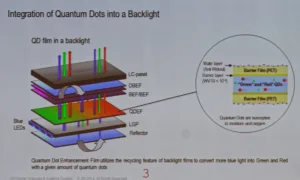 The next speaker was Michael Patz from 3M Germany and he talked about quantum dots (QDs). QDs are semiconductors that act as phosphors. The tiny particles, around 3nm, will emit pure green light at 535nm, for example. The light is of a very narrow bandwidth and by changing the chemistry and size, you can change the light colour very precisely.
The next speaker was Michael Patz from 3M Germany and he talked about quantum dots (QDs). QDs are semiconductors that act as phosphors. The tiny particles, around 3nm, will emit pure green light at 535nm, for example. The light is of a very narrow bandwidth and by changing the chemistry and size, you can change the light colour very precisely.
The RGB balance can be designed to optimise the light for LCD backlighting.
QDs can be put on the LED die or on the edge of the LGP in a side-emission display but in both these cases, the heat from the LED can degrade the QDs.
The other way is to put the QDs into a film which moves them away from the heat of the LED. Using a reflective polariser and backlight recycling (DBEF) means that light goes through the film multiple times, which optimises the value of the “expensive” QD material, which is also susceptible to water and oxygen. Each time the blue light passes through the film, more is converted to red and green, so there is a bit of engineering optimisation that can be done to manage the white point of the display.DBEFs make QDs more economical
More recycling also increases the green and red content, allowing a wider gamut (in conjunction with recycling).
The choice of the Blue LED light changes things – shorter wavelengths are more effective in terms of the efficiency. Longer wavelength blue LEDs suffer from leaks into the green filter, reducing the colour gamut, so the choice of blue LED also affects the colour.
The wider you go in gamut, the less brightness is perceived (however you achieve it). This is a perception and optical effect, so is not a result of using QDs, simply of increasing the gamut.
Quantum dots can also be used to deliver higher efficiency by using weaker colour filters to achieve a standard gamut.
Patz talked about the 3M research on the perception of the importance and also the importance of colour accuracy, which we covered in our SID report last year.
There was some discussion about the issues of QDs containing cadmium. The cadmium cannot “leak” out of the QDs and there are power savings (and cadmium is released into the environment by power generation, so that is a “balancing factor” for environmental considerations – Man. Ed.), so there are no issues of safety – QDs with cadmium have an exemption from ROHS regulations in the EU.
In response to a question Patz said that the automotive industry doesn’t want to use cadmium, even though the materials are inert and meet the EU ROHS etc requirements. It’s not really a matter of safety, as someone pointed out, it’s the marketing and environmental policies of the car makers.

